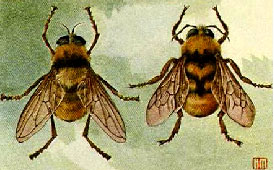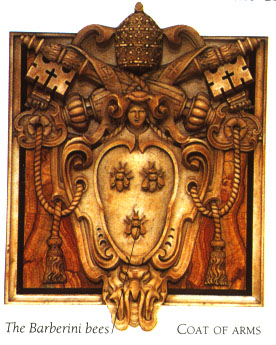

 .....
..... 
The bee has significance in many cultures. The bee carries pollens from plant to plant, so it associated with the success of crops. That is why many farmers, fruit growers, and gardeners keep bees. Bees are coated all over with fuzzy down to which pollen adheres. Their legs have "pollen pockets." The common honey-bee belongs to the order Hymenoptera, and the family Apidae. Each hive has between twenty to forty thousand worker bees, with one queen. The queen lives for three to four years and lays as many as three to four thousand eggs in a twenty-four hour day. The queen mates once with a drone and she has fertilized eggs for life. The eggs produce bees after a twenty-four day gestation period.
Honeybees are normally tree cavity nesters. In South America, domesticated honeybees were crossed with a ferocious strain of African honey bees, in an attempt to improve honey yields. Some of the African bees escaped from their Brazilian test lab. These bees are called "killer bees." They attack in large swarms and over 300 people have been killed from 1957 until 1979. Now these bees have traveled north from Brazil and some have entered Mexico and the southwestern U.S.A.
The Bumble Bee can bore into wood to build a nest. Their elongated mouth-parts enable them to pollinate red clover, which no other bee can do.
Two of my great-grandmothers had Iroquois blood, and one raised bees. Bees used to swarm all over her and she never got stung. My father said she never used netting. You could say she was a "Bee Shaman." She had healing skills and was also considered a "medicine woman." I have her bee book and was told some of her bee legends, by both my dad and grandmother. My grandmother, Ermina, would go to a hive and carefully subdue the bees with smoke before removing the honeycombs to get the honey from same.
As soon as there were humans, they began to collect honey. Sweet bush clover is a good source of honey. Honey is easy on your stomach. Two teaspoons of honey added to a cup of hot water is soothing to the throat.
Bees were thought to be conductors of souls from this world. There would be no fruit and flowers without bees to pollinate them, by flying from blossom to blossom.
Bees sting beekeepers that go to the hives right after cleaning up their barns. Bees hate the odor of cattle and horses. Kicking or bumping the hives make bees angry.
FAMOUS PEOPLE OF LONGEVITY WHO ATE HONEY:
It has been studied and beekeepers do not seem to get cancer.
THE BRITONS AND THE CELTS:
ANCIENT EGYPT:
GREEK AND ROMAN:
THE CHINESE:
MESOAMERICA:
Spirits can be distilled from anything which can be induced to ferment.
Anything containing sugar can be turned into alcohol.
VIKINGS:
The Finnish Kalevala tells how Lemminkainen was restored to life by magic honey from Mehilainen, the bee.
CHRISTIANITY:

POLAND:
Knipnikas is a Lithuanian honey liquor, similar to mead ((a fermented liquor of honey and yeast), but with ginger, cloves, and nutmeg for flavor.
IN HERALDRY:
In heraldry, bees usually appear in groups, as in the arms of the Corsican Buonaparte family. They symbolized diligence and a sense of order.
LINK:
SOURCES:
Biederman, Hans. Dictionary of Symbolism New York: Meridian Books, 1992.
Biggle, Jacob. Biggle Bee Book. Philadelphia: Wilmer Atkinson Co., 1913.
Buxton, Simon. The Shamanic Way of the Bee. Rochester, Vt.: Destiny Books, 2004.
Conway, D.J. Animal Magick. St Paul: Llewellyn Publications, 2001.
Jordan, Michael. Encyclopedia of Gods. New York: Facts on File, Inc., 1993.
Saunders, Nicholas J. Animal Spirits [part of the "Living Wisdom" Series]. Alexandria, VA: Time-Life Books, 1995.
Sparrow (editor), Linda. Ancient Healing. Lincolnwood, IL.: Publications International, Ltd., 1997.